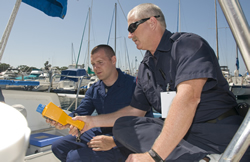The Countering Weapons of Mass Destruction (CWMD) Office was established in December 2017 by consolidating primarily the Domestic Nuclear Detection Office, a majority of the Office of Health Affairs, as well as other DHS elements.
For current information related to CWMD, please visit the following:

The transit and border layer (trans-border) is composed of transit to the U.S. from a foreign port of departure or non-port of departure, as well as passing through the U.S. border prior to entering the U.S. interior. This represents the last opportunity to detect radiological or nuclear materials prior to their arrival onto U.S. territory, and initiatives in this layer emphasize maritime domain awareness related to preventive radiological/nuclear detection.
At the U.S. border, the first point at which the United States can exercise full control over detection assets, significant resources are concentrated at ports of entry, with careful consideration given to detecting threats without impeding the flow of commerce and people.
The trans-border layer includes consideration of the following:
- Maritime modes of transportation such as public and private vessels operating on international waters, U.S. coastal and inland waterways, and seaports/maritime points of entry
- Air modes of transportation that include commercial and general aviation aircraft via cargo, baggage, and passengers
- Land modes of transportation through points of entry or across non-points of entry along the U.S. border with Mexico or Canada, that include
- private and public automobile traffic,
- international rail, and
- various types of off-road travel.
